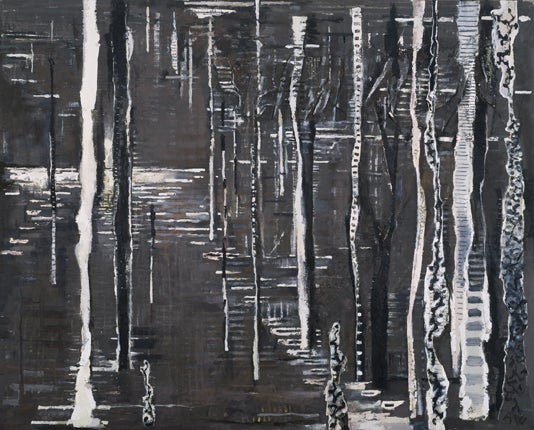Anthony Whishaw RA: Images on the Edge of Perception, Kings Place Gallery, London
Anthony Whishaw, 80 this year, is a painter who seeks to be both British and modern – and that is a difficult identity to forge

Your support helps us to tell the story
From reproductive rights to climate change to Big Tech, The Independent is on the ground when the story is developing. Whether it's investigating the financials of Elon Musk's pro-Trump PAC or producing our latest documentary, 'The A Word', which shines a light on the American women fighting for reproductive rights, we know how important it is to parse out the facts from the messaging.
At such a critical moment in US history, we need reporters on the ground. Your donation allows us to keep sending journalists to speak to both sides of the story.
The Independent is trusted by Americans across the entire political spectrum. And unlike many other quality news outlets, we choose not to lock Americans out of our reporting and analysis with paywalls. We believe quality journalism should be available to everyone, paid for by those who can afford it.
Your support makes all the difference.Never one to pass up a cliché, I stood in front of Anthony Whishaw's Lyminge Forest and thought of waking in a dark wood in the middle of one's days.
Although Whishaw turned 80 this year, he was 60 when he started this large canvas, which makes the Divine Comedy more apropos. His painting, odd and lovely, asks the kind of things an artist might at the end of the first stage of his career – questions such as "Where am I?" and "What am I doing here?", the ones that troubled Dante halfway through his own life; good questions to ask when you're in a dark wood.
For Whishaw, though, they have an added relevance. He is almost exactly the same age as Bridget Riley, a painter for whom the term "modern" might have been coined. Not so Whishaw. Woods are not modern. The desire to paint stands of silver birch taps into a strain in Romanticism – specifically in English Romanticism – that winds its way back through Paul Nash and the Pre-Raphaelites to Samuel Palmer, Joseph Wright and beyond. It is a tendency that has proved strangely resilient, and not always in a good way. In the mid-1930s, Ben Nicholson was on the point of becoming a European painter, an artist making abstract white reliefs in the Modernist tradition. By 1940, he was back painting Cornish fishing boats. In the 1930s, Nash too asked how it was possible to "go modern" and "be British" at the same time, concluding roughly that it wasn't. It's a problem that is still implied in the division of the old Tate Gallery into Modern and British, as though the two were mutually exclusive.
So which of the two Tates would Whishaw be shown in? That is the crossroads at which he finds himself in 1991 in Lyminge Forest. The picture is big – about 8ft by 10ft – and at first glance it looks like 1950s wallpaper: strongly graphic black-and-white saplings flattened against a brown field arranged horizontally, as though Whishaw is inviting us to see his wood as a sylvan Modernist grid. Closer inspection shows this impression of graphic ease to be quite wrong, likewise the sense of Lyminge Forest as old-fashioned. Up close, the picture falls apart, its surface broken up by some very un-lyrical things, among them what look like sheets of hessian collaged to the canvas with Robert Rauschenberg's acrylic. From a foot away, Lyminge Forest might be painted in mud, like an Andy Goldsworthy mural transferred to canvas. What read as saplings from 10ft off are now a series of marks or cells, like strips of celluloid. So rough – violent, really – is Whishaw's handling of the surface that it is hard to tell whether his birches are made by layering paint on to canvas or by ripping it off in strips.
Lyminge Forest is both the picture of a wood and an image that merely shares certain qualities with a wood, an ambiguity, a melancholy, a vague air of threat. And yet both of these co-existent paintings could only ever be English. How would another child of the forest – a German, say – have dealt with the subject?
Look at Whishaw's more recent paintings and you find Anselm Kiefer's forest works coming to mind. Water's Edge seems to have taken five years to do – it is dated 2001-2006 – which accounts for its geological feel. As with Kiefer, pigment becomes history. The painting of woodland is both a German and a British tradition, but painting woods Germanically carries with it all kinds of historical complexities: Hitler was a big Caspar David Friedrich fan, after all. Whishaw's problems are both much smaller and much greater. They come back to Paul Nash's problem, spelt out in an article in The Studio nearly 80 years ago, which is how to be British and modern at the same time. You can paint forests in a modern way, but only by playing around with history rather than buying into it. Think of Peter Doig. Whishaw, though, doesn't want to be a Post-Modernist. He wants to be both a British painter and a modern one, and that is a much harder thing to do.
Anthony Whishaw (020 7520 1485), to 8 Oct
Next Week:
Charles Darwent sees proposals for the next fourth plinth project in Trafalgar Square, London, among them, a giant musical cash machine
Join our commenting forum
Join thought-provoking conversations, follow other Independent readers and see their replies
Comments